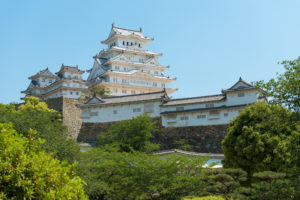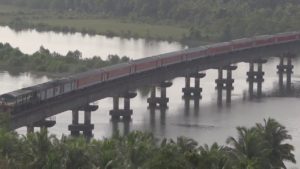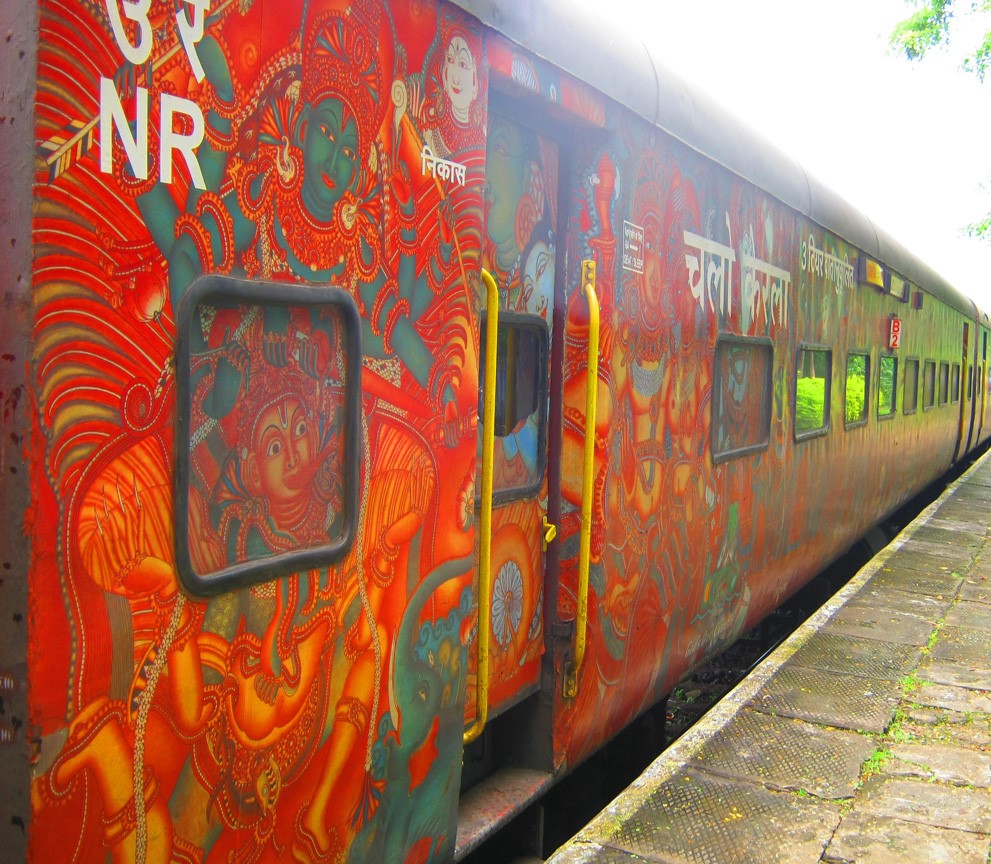
Indian Railways (IR) is India’s national railway system operated by the Ministry of Railways. It manages the fourth largest railway network in the world by size, with a route length of 67368-kilometre (41861 mi) and total track length of 121407-kilometre (75,439 mi) as of March 2017. I travelled a lot on trains in India since childhood discovering most of India – My first love of trains and romance of train journeys (especially non-routine, mountain, forest & special route railways) started with Indian Railways and continues today as with the Railways from around the world !
INDIAN RAILWAYS : BRIEF
Indian Railways (IR) is India’s national railway system operated by the Ministry of Railways
- It manages the fourth largest railway network in the world by size
- With a route length of 67368-kilometre (41861 mi) and total track length of 121407-kilometre (75,439 mi) as of March 2017
- Routes are electrified with 25 kV AC electric traction while 33% of them are double or multi-tracked
- Indian Railway (IR) runs more than 20,000 passenger trains daily, on both long-distance and suburban routes from 7,349 stations across India
- The trains have five-digit and four-digit numbering system
- Mail or Express trains, the most common types, run at an average speed of 50.6 kilometres per hour (31.4 mph)
- Most premium passenger trains like Rajdhani, Shatabdi Exp run at peak speed of 140–150 km/h (87–93 mph) with Gatiman Express between New Delhi and Agra touching peak speed of 160 km/h (99 mph)
- Indian railways has also started a pilot project by the name of “Train-18”, with successful trials between Delhi-Varanasi and Lucknow-Delhi and clocked maximum track speed of 180 km/h (112mph)
- In the freight segment, IR runs more than 9200 trains daily
- The average speed of freight trains is around 24 kilometres per hour (15 mph)
- Maximum speed of freight trains varies from 60 to 75 km/h (37 to 47 mph) depending upon their axle load with container special running at a peak speed of 100 km/h (62 mph)
- As of March 2017, Indian Railway’s rolling stock consisted of 277987 freight wagons, 70937 passenger coaches and 11452 locomotives
- IR owns locomotive and coach-production facilities at several locations in India. The world’s eighth-largest employer, it had 1.308 million employees as of March 2017
- In the year ending March 2018, IR carried 8.26 billion passengers and transported 1.16 billion tonnes of freight
- In the fiscal year 2017–18, IR is projected to have revenue of ₹1.874 trillion (US$27 billion), consisting of ₹1.175 trillion (US$17 billion) in freight revenue and ₹501.25 billion (US$7.3 billion) in passenger revenue, with an operating ratio of 96.0 percent
INDIAN RAILWAYS : BRIEF HISTORY
- The first railway proposals for India were made in Madras in 1832
- The country’s first train, Red Hill Railway (built by Arthur Cotton to transport granite for road-building), ran from Red Hills to the Chintadripet bridge in Madras in 1837
- In 1845, the Godavari Dam Construction Railway was built by Cotton at Dowleswaram in Rajahmundry, to supply stone for the construction of a dam over the Godavari River
- In 1851, the Solani Aqueduct Railway was built by Proby Cautley in Roorkee to transport construction materials for an aqueduct over the Solani River
- India’s first passenger train, hauled by three steam locomotives (Sahib, Sindh and Sultan), ran for 34 kilometres (21 mi) with 400 people in 14 carriages on 1,676 mm (5 ft 6 in) broad gauge track between Bori Bunder (Mumbai) and Thane on 16 April 1853
- The Thane viaducts, India’s first railway bridges, were built over the Thane creek when the Mumbai-Thane line was extended to Kalyan in May 1854
- Eastern India’s first passenger train ran 24 miles (39 km) from Howrah, near Kolkata, to Hoogly on 15 August 1854
- The first passenger train in South India ran 60 miles (97 km) from Royapuram- Veyasarapady (Madras) to Wallajah Road (Arcot) on 1 July 1856
- On 24 February 1873, a horse-drawn 3.8-kilometre (2.4 mi) tram opened in Calcutta between Sealdah and Armenian Ghat Street
- On 9 May 1874, a horse-drawn tramway began operation in Bombay between Colaba and Parel
- In 1897, lighting in passenger coaches was introduced by many railway companies. On 3 February 1925, the first electric passenger train in India ran between Victoria Terminus and Kurla
- The organization of Indian railways into regional zones began in 1951 when the Southern (14 April 1951), Central (5 November 1951) and Western (5 November 1951) zones were created
- Fans and lights were mandated for all compartments in all passenger classes in 1951 and sleeping accommodations were introduced in coaches
- In 1956, the first fully air-conditioned train was introduced between Howrah and Delhi
- Ten years later, the first containerized freight service began between Mumbai and Ahmedabad
- In 1986, computerized ticketing and reservations were introduced in New Delhi
- In 1988, the first Shatabdi Express was introduced between New Delhi and Jhansi; it was later extended to Bhopal
- Two years later, the first self-printing ticket machine (SPTM) was introduced in New Delhi
- In 1993, air-conditioned three-tier coaches and a sleeper class (separate from second class) were introduced on IR. The CONCERT system of computerized reservations was deployed in New Delhi, Mumbai and Chennai in September 1996
- In 1998, coupon validating machines (CVMs) were introduced at Mumbai Chhatrapati Shivaji Maharaj Terminus
- The nationwide Concierge system began operation on 18 April 1999
- In February 2000, the Indian Railways website went online
- On 3 August 2002, IR began online train reservations and ticketing
- Indian Railways announced on 31 March 2017 that the country’s entire rail network would be electrified by 2022
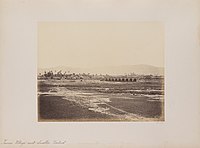
The smaller railway viaduct near Thane in 1855

The longer railway viaduct near Thane in 1855
INDIAN RAILWAYS
ORGANIZATION & STRUCTURE
- Indian Railways is headed by a seven-member Railway Board whose chairman reports to the Ministry of Railways
- Railway Board also acts as the Ministry of Railways
- The officers manning the office of Railway Board are mostly from organised Group A Railway Services and Railway Board Secretariat Service
- IR is divided into 18 zones, headed by general managers who report to the Railway Board
- The zones are further subdivided into 68 operating divisions, headed by divisional railway managers (DRM)
- The divisional officers of the engineering, mechanical, electrical, signal and telecommunication, stores, accounts, personnel, operating, commercial, security and safety branches report to their respective DRMs and are tasked with the operation and maintenance of assets
- Station masters control individual stations and train movements through their stations’ territory
- In addition, there are a number of production units, training establishments, public sector enterprises and other offices working under the control of the Railway Board
INDIAN RAILWAYS
SUBSIDIARIES & UNDERTAKINGS
IR is a major shareholder in 16 public sector undertakings (PSU) and other organizations that are related to rail transport in India. Notable among this list include :
FINANCING, CONSTRUCTION, & PROJECT MANAGEMENT
- IRFC : Indian Railways Finance Corporation
- RITES : Rail India Technical & Economic Services
- IRCON : Indian Railway Construction
- MRVC :
- RVNL – Rail Vikas Nigam Limited
LAND & STATION DEVELOPMENT
- RLDA : Rail Land Development Authority
- IRSDC : Indian Railway Stations Development Corporation
RAIL INFRASTRUCTURE
- DFCCIL : DEDICATED FREIGHT CORRIDOR CORPORATION OF INDIA Limited
- PRCL :
PASSENGER & FREIGHT TRAIN OPERATIONS
- KRCL : Konkan Railway Corporation Limited
- CONCOR : Container Corporation of India
INFORMATION TECHNOLOGY (IT) & COMMUNICATIONS
- CRIS : Centre for Railway Information Systems
- RCIL :
CATERING, TICKETING & TOURISM
- IRCTC : Indian Railways Catering & Tourism Corporation
INDIAN RAILWAYS : HUMAN RESOURCES
- Staff are classified into gazetted (Groups A and B) and non-gazetted (Groups C and D) employees
- Gazetted employees carry out executive / managerial / officer level tasks. As of March 2017, the number of personnel (Groups A & B) constitutes 1.2% of the total strength, while Group C & D account for 92.6% and 6.2% respectively
- There is no direct recruitment of Group B employees in Indian Railways, it’s only promotional, Group B employees are recruited from departmental promotional exam of Group C employees
- Recruitment of Group A employees is carried out by the Union Public Service Commission Civil Service exam by examination
- Recruitment of Group C junior engineers and depot material superintendents is conducted by the Railway Recruitment Board
- Group C employees are recruited by 21 Railway Recruitment Board or RRB, which are controlled by the Railway Recruitment Control Board (RRB)
- Group D staffs are recruited by 16 Railway Recruitment Cells or RRCs
- The training of all groups is shared among seven centralized zonal training institutes and 295 training centers located all over India
- IR offers housing and runs its own hospitals, schools and sports facilities for the welfare of its staff
INDIAN RAILWAYS : ROLLING STOCK
LOCOMOTIVES


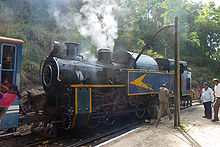
- India uses electric and diesel locomotives, along with a few CNG (compressed natural gas) locomotives
- Steam locomotives are no longer in use, except in heritage trains
- Locomotives in India are classified by gauge, motive power, the work they are suited for and their power or model number
- Their four- or five-letter class name includes this information
- The first letter denotes the track gauge; the second their motive power (diesel or electric), and the third their suitable traffic (goods, passenger, multi or shunting)
- The fourth letter denotes a locomotive’s chronological model number
- In 2002, a new classification was adopted in which the fourth letter indicates a newer diesel locomotive’s horsepower range
- A locomotive may have a fifth letter in its name, denoting a technical variant, subclass or sub-type (a variation in the basic model (or series) or a different motor or manufacturer)
- In the new diesel-locomotive classification, the fifth letter refines the horsepower in 100-hp increments : A for 100 hp, B for 200 hp, C for 300 hp an so on
- In this classification, a WDM-3A is a 3100 hp, a WDM-3D a 3400 hp and a WDM-3F a 3600 hp locomotive
- Diesel locomotives are fitted with auxiliary power units, which save almost 88 percent of fuel during idle time when a train is not running
GOODS WAGONS
- As of March 2017, IR fleet consisted of 277,987 goods wagons
- They carried 1110 million tonnes of freight in Fiscal Year 2016–17
- Wagon types used by IR include BCACBM, BCCN, BCNA, BCNHL, BOBRN, BOBYN, BOXN (BOXN-HL, BOXN-HS, BOXN-HL, BOXN-CR, BOXN-LW, BOXN-AL, BOXN-EL), BRH, BTPGLN, BTPN and VVN
- IR’s bulk requirement of wagons is met by wagon manufacturing units both in public and private sectors as well as other Public Sector Units under the administrative control of Ministry of Railways
PASSENGER COACHES
- On long distance routes and also on some shorter routes, IR uses 2 primary types of coach design types
- ICF coaches, in production from 1955 until Jan 2018 constitute the bulk of the current stock
- These coaches, considered to be having inadequate safety features, are slowly being phased out
- As of September 2017 – around 40000 coaches are still in operation
- The older coaches are being replaced with LHB coaches
- Introduced in mid ’90s, these coaches are lighter, safer and are capable of speeds up to 160 kilometres per hour (99 mph)
- IR has announced that two new self-propelled train set designs will be introduced starting from mid 2018
- These two train types, termed as Train-18 and Train-20, are expected to replace locomotive-hauled trains on long distance routes
- On regional short distance routes, IR runs Mainline Electrical Multiple Unit (MEMU) or Diesel Electrical Multiple Unit (DEMU) trains, depending on the traction available
- These train sets are self-propelled with capability for faster acceleration or deceleration and are expected to reduce congestion on dense routes
- Passenger locomotive-hauled trains, having frequent stops are slowly being replaced with train sets across India
- On suburban commuter routes around the large urban centers, IR runs trains with Electric Multiple Unit (EMU) coaches
- As of March 2017, about 9100 coaches are in operation
INDIAN RAILWAYS : MANUFACTURING
Indian Railways is a vertically-integrated organization that produces majority of its locomotives & rolling stock at in-house production units, with a few recent exceptions
LOCOMOTIVES
- Chittaranjan Locomotive Works in Chittaranjan, West Bengal manufactures electric locomotives
- Diesel Locomotive Works in Varanasi, Uttar Pradesh manufactures diesel & electric locomotives.
- Diesel Locomotive Factory in Marhowra, Bihar. It’s a Joint Venture of Indian Railways & General Electric
- They manufacture high capacity diesel locomotives, used especially for freight transportation
- Electric Locomotive Factory in Madhepura, Bihar. It’s a Joint Venture of Indian Railways and Alstom SA. They manufacture electric locomotives
- Diesel-Loco Modernisation Works in Patiala, Punjab upgrades & overhaul the locomotive.They also manufacture electric locomotives
ROLLING STOCK
- Integral Coach Factory in Chennai, Tamilnadu
- Rail Coach Factory in Kapurthala, Punjab
- Modern Coach Factory in Raebareli, Uttar Pradesh
WHEEL & AXLE
- Rail Wheel Factory in Bangalore, Karnataka
- Rail Wheel Plant, Bela in Chhapra, Bihar
REPAIR & MAINTENANCE
The repair and maintenance of this vast fleet of rolling stock is carried out at 44 loco sheds, 212 carriage & wagon repair units and 45 periodic overhaul workshops located across various zones of IR
INDIAN RAILWAYS : NETWORK
TRACKS

Comparison of gauges in India with the standard gauge
- As of March 2017, IR network spans 121407 km (75439 mi) of track length, while the route length is 67368 km (41861 mi)
- The Indian Railways, as of 1st April 2019, had a Broad-Gauge network of 64298 km. Out of this – 35488 km was electrified
- Track sections are rated for speeds ranging from 80 to 200 km/h (50 to 124 mph), though the maximum speed attained by passenger trains is 180 km/h (110 mph) during trial runs
- As of March 2017, most of the broad-gauge network is equipped with long-welded rails, pre-stressed concrete (PSC) sleepers with elastic fastenings and high tensile strength 52kg/60kg 90 UTS rails
- 1676 mm (5 ft 6 in) broad gauge, is the predominant gauge used by IR and spans 61680 km (38330 mi) of route (92% of total route network)
- It is among the broadest gauge in use across the world for passenger movement
- Broad gauge generated 100% of the freight output (Net tonne-Kilometres) and more than 99% of the passenger output (Passenger Kilometres) in the fiscal year 2016–17
- The 1,000 mm (3 ft 3 3⁄8 in) metre gauge tracks ; 762 mm (2 ft 6 in) and 610 mm (2 ft) narrow gauge tracks are present on fewer routes
- All of these routes, except the heritage routes, are being converted to broad gauge
- The metre gauge tracks were 3479 kilometres (2162 mi) (5% of total route network) and narrow gauges tracks were 2208 km (1372 mi) (3% of total route network) as of 31 March 2017
- Indian Railway has taken massive initiative for achieving fully mechanised maintenance of her tracks with state of art track machines
ELECTRIFICATION
- As of 31 March 2018, IR has electrified 49% or 33057 km (20541 mi) of the route kilometers and 46% or 55240 km (34320 mi) of the total running track
- India uses 25 kV AC traction on all its electrified tracks
- Railway electrification in India began with the first electric train, between Bombay Victoria Terminus and Kurla on the Harbour Line, on 3 February 1925 on the Great Indian Peninsula Railway (GIPR) at 1500 V DC
- Heavy gradients in the Western Ghats necessitated the introduction of electric traction on the GIPR to Igatpuri on the North East line and Pune on the South East line
- On 5 January 1928 1500 V DC traction was introduced on the suburban section of the Bombay, Baroda and Central India Railway between Colaba and Borivili, and between Madras Beach and Tambaram of the Madras and Southern Mahratta Railway on 11 May 1931, to meet growing traffic needs
- The 3000 V DC electrification of the Howrah-Burdwan section of the Eastern Railway was completed in 1958
- The first 3000 V DC EMU service began on the Howrah-Sheoraphuli section on 14 December 1957
- Research and trials in Europe, particularly on French Railways (SNCF), indicated that 25 kV AC was an economical electrification system
- Indian Railways decided in 1957 to adopt 25 kV AC as its standard, with SNCF their consultant in the early stages
- The first 25 kV AC section was Raj Kharswan–Dongoaposi on the South Eastern Railway in 1960
- The first 25 kV AC EMUs, for Kolkata suburban service, began service in September 1962. For continuity, the Howrah–Burdwan section of the Eastern Railway and the Madras Beach–Tambaram section of the Southern Railway were converted to 25 kV AC by 1968
- Because of limitations in the DC traction system, a decision was made to convert the electric traction system of the Mumbai suburban rail network of WR and CR from 1.5kV DC to 25 kV AC in 1996–97
- The conversion from DC to AC traction was completed in 2012 by Western Railway, and in 2016 by Central Railway. Since then, the entire electrified mainline rail network in India uses 25 kV AC, and DC traction is used only for metros and trams
- Indian Railways announced on 31 March 2017 that the country’s entire rail network would be electrified by 2022
- Though not a nascent concept, the electrification in India now has been committed with a fresh investment of ₹35000 crore (US$5.1 billion) to electrify the entire network and eliminating the cost of fuel under transportation which will amount to a massive savings of ₹10500 crore (US$1.5 billion) overall
- This will be a boon for savings for the Government to channelize the investments in modernization of the railway infrastructure
- Close to 30 billion units of electricity will be required for railway electrification on an annual basis by 2022, leading to excellent opportunities for IPPs of conventional power
SIGNALING & TELECOMMUNICATION
- IR uses a range of signalling technologies and methods to manage its train operations based on traffic density and safety requirements.
- As of March 2017 – around 2850 km (1770 mi) of the route uses automatic block signalling for train operations – concentrated in high density routes, large cities and junctions
- Remaining routes are based on absolute block signalling with trains manually controlled by signal men from the signal boxes typically located at stations
- Few low density routes still use manual block signalling methods with communication on track clearance based on physical exchange of tokens
- In a few sections, intermediate block signalling is provided to further enhance line capacity with minimal investment
- As of March 2017, 501 block sections have intermediate block signals on IR
- IR primarily uses coloured signal lights, which replaced semaphores and disc-based signalling (dependent on position or colour)
- IR uses two-aspect, three-aspect and four (or multiple) aspect color signalling across its network
- Signals at most stations are interlocked using panel interlocking , route-relay interlocking or electronic interlocking methods that eliminate scope for human signalling errors
- IR uses track circuiting and block proving axle counters for train detection
- As of March 2017, 5584 stations across IR (about 90% of stations on broad gauge) have interlocked stations and multi-aspect signalling
- Around 99% of key routes (A, B, C and D) have track circuitry or block proving axle counters for automated train detection
- Also, IR has about 51,000 route kilometers of optical fiber cable network across India, that is used for train control, voice and data communication
- Around 2500 km (1600 mi) of the route is covered by GSM-R based Mobile Train Radio Communication
- In December 2017, IR announced that it will implement ETCS Level 2 system for signalling and control on key routes with an investment of ₹12,000 crore (US$1.7 billion)
- Currently IR uses Centralised Traffic Control (CTC) on the busy Ghaziabad – Kanpur route and real-time train monitoring systems on Mumbai and Kolkata suburban routes
INDIAN RAILWAYS
LINKS WITH ADJACENT COUNTRIES
Rail links between India and neighboring countries are not well developed
PAKISTAN
- Two trains operate to Pakistan : the Samjhauta Express between Delhi and Lahore and the Thar Express between Jodhpur and Karachi. But as of August 2019 – they have been cancelled due to the tension over Kashmir
BANGLADESH
- Bangladesh is connected by the four times a week Maitree Express that runs from Kolkata to Dhaka and weekly Bandhan Express which began running commercial trips between Kolkata and Khulna in November 2017
- Indian and Bangladeshi governments has started work on a new rail link to ease surface transport
- India will build a 13 km (8.1 mi) railway linking Tripura’s capital Agartala with Bangladesh’s southeastern city of Akhaura – an important railway junction connected to Chittagong port resource – rich Sylhet and Dhaka
- Total cost of the proposed project is estimated at ₹252 crore (US$36 million)
- The Indian Railway Construction Company (IRCON) is constructing the new railway tracks on both sides of the border
- Of the 13 km (8.1 mi) rail line, 5 km (3.1 mi) of tracks fall in Indian territory
- The Northeast Frontier Railways (NFR) is laying the connecting tracks for the new rail link on the Indian side, up to Tripura’s southern-most border town, Sabroom – 135 km (84 mi) south of Agartala. From Sabroom, the Chittagong international sea port is 72 km (45 mi) away
NEPAL
- Two rail links to Nepal exist : passenger service between Jainagar and Bijalpura and freight services between Raxaul and Birganj
MYANMAR
- No rail link exists with Myanmar but a railway line is to be built from Jiribam (in Manipur) to Tamu through Imphal and Moreh
- The construction of this missing link, as per the feasibility study conducted by the Ministry of External Affairs through RITES Ltd, is estimated to cost ₹29.41 billion (US$430 million)
BHUTAN
- An 18 km (11 mi) railway link with Bhutan is being constructed from Hashimara in West Bengal to Toribari in Bhutan
CHINA, SRILANKA : No rail link exists with either China or Sri Lanka
INDIAN RAILWAYS : SERVICES
PASSENGER SERVICE
STATION CATEGORIES
- From December 2017, stations are categorised into the Non-Suburban Group NSG1 to NSG6, the Suburban Group SG1 to SG3, and the Halt Group HG1 to HG3 based on the earnings, passenger footfall and strategic importance
- Before December 2017, stations were classified into A1, A, B, C, D, E and F categories, based only on the passenger earnings from the sales of platform tickets, thus limiting the ability of IR to better focus its investments in passenger amenities
TRAVEL CLASSES
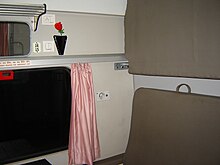
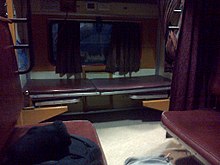

- IR has several classes of travel, with or without air-conditioning
- A train may have one or several classes
- Slow passenger trains have only unreserved seating and the Rajdhani Express, Shatabdi Express, Garib Rath Express, Double Decker Express, Tejas Express, Humsafar Express , Duronto Express , Yuva Express and Vande Bharat Express have only air-conditioned classes
- Fares for all classes differ, and unreserved seating is the least expensive
- Fares for the Rajdhani, Duronto Shatabdi and Vande Bharat Express trains include food
- In September 2016, IR introduced dynamic fares for the Rajdhani, Duronto and Shatabdi trains (except 1AC and EC classes) to increase revenue
- Long-distance trains usually include a pantry car and food is served at the berth or seat itself
- Luxury trains (such as Palace on Wheels) have separate dining cars, but these trains cost as much as—or more than—a five-star hotel room
- A standard passenger rake has four unreserved (general) compartments, two at the front and two at the rear (one of which may be for women)
- The number of other coaches varies by demand and route
- A luggage compartment may be at the front or the rear
- On some mail trains, a separate mail coach is attached. Lavatories are communal, and Indian- and Western-style
- The classes in operation are (although a train may not have all these classes) :

Inside an Indian Railways Sleeper Coach
Class |
Description |
|---|---|
|
Saloon |
|
|
1A |
|
|
2A |
|
|
3A |
|
|
3E |
|
|
Vistadome |
|
|
EA |
|
|
EC |
|
|
CC |
|
|
SL |
|
|
2S |
|
|
UR/GEN |
|
- At the rear of the train is the guard’s cabin
- It contains a transceiver, and is where the guard usually gives the all-clear signal before the train departs
INDIAN RAILWAYS : TYPES OF TRAINS
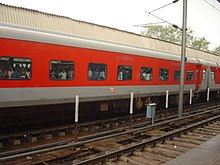
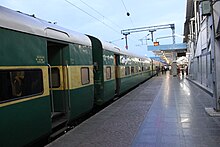
- Trains are sorted into categories which dictate the number of stops on a route, their priority on the network and their fare structure
- Each express train is identified by a five-digit number
- if the first digit is 1 or 2 in the train number, they are long-distance express trains
- If the first digit is 0, the train is a special train which will operate for a limited period of time with a different fare structure
- A first digit of 5 denotes a passenger train
- The second digit indicates the zone operating the train
- However, for high-speed trains, the second digit is either 0 or 2 (the first remains 1 or 2)
- The third digit denotes the division within the zone which is responsible for maintenance and cleanliness, and the last two digits are the train’s serial number
- The train numbering system was changed from four digits from December 2010 to accommodate an increasing number of trains.
- Trains traveling in opposite directions along the same route are usually labelled with consecutive numbers
- However, there is considerable variation in train numbers; some zones, such as Central Railway, have a less-systematic method of numbering trains
- Trains are classified by average speed
- A faster train has fewer stops (halts) than a slower one, and is usually used for long-distance travel
- Most express trains have special names to identify them easily
- The names of the trains usually denote the regions they connect, the routes they traverse, or a famous person or tourist spot connected with the train. For example : Andhra Pradesh Express connects New Delhi to Visakhapatnam
Train types |
Description of Train |
|---|---|
|
Vande Bharat Express
|
|
| Tejas Express |
|
| Gatimaan Express |
|
| Shatabdi Express |
|
| Rajdhani Express |
|
| Duronto Express |
|
| Humsafar Express |
|
| AC Express |
|
| Double Decker Express |
|
| Uday Express |
|
| Garib Rath Express |
|
| Yuva Express |
|
| Jan Shatabdi Express |
|
| Sampark Kranti Express |
|
| Kavi Guru Express |
|
| Vivek Express |
|
| Rajya Rani Express |
|
| Mahamana Express |
|
| Intercity Express |
|
| Antyodaya Express |
|
| Jan Sadharan Express |
|
| Suvidha Express |
|
| Superfast Express |
|
| Express |
|
|
|
| Passenger |
|
| Suburban |
|
| Metro |
|
| Mountain Railways |
|
INDIAN RAILWAYS : TOURISM
Indian Railway operates tourist train or coach services on popular tourist circuits in different regions of the country. The service offers tour packages inclusive of rail travel, local transportation, accommodation, food and guided tours
- IR offers various tourist services in this segment including Luxury tourist trains, Semi luxury trains, Buddhist special trains, Bharat Darshan trains, Aastha Circuit trains and Steam trains
- The Palace on Wheels is a luxury-train service, frequently hauled by a steam locomotive, to promote tourism in Rajasthan. The train has a seven-night, eight-day itinerary on a round trip from New Delhi via Jaipur, Sawai Madhopur and Chittaurgarh, Udaipur, Jaisalmer, Jodhpur, Bharatpur and Agra
- Royal Rajasthan on Wheels covers a number of tourist destinations in Rajasthan. The seven-day, eight-night tour is a round trip from New Delhi’s Safdarjung station via Jodhpur, Udaipur and Chittaurgarh, Ranthambore National Park and Jaipur, Khajuraho, Varanasi and Sarnath, and Agra
- Maharajas’ Express : A luxury train operated by the Indian Railway Catering and Tourism Corporation (IRCTC), runs on five routes to about 12 destinations across north-West and central India (centered around Rajasthan) from October to April
- The Deccan Odyssey covers tourist destinations in Maharashtra and Goa. Its seven-night, eight-day tour begins in Mumbai and stops at Jaigad Fort, Ganapatipule and Ratnagiri, Sindhudurg, Tarkarli and Sawantwadi, Goa, Kolhapur and Pune (Day 5), Aurangabad and Ellora Caves, and Ajanta Caves and Nashik
- The Golden Chariot runs on two tours : Pride of the South and Splendor of the South. The Golden Chariot is a luxury train service
- The Mahaparinirvan Express : an air-conditioned service also known as the Buddhist Circuit Train, is run by the IRCTC for Buddhist pilgrims. Its seven-night, eight-day tour begins in New Delhi and visits Bodh Gaya, Rajgir and Nalanda, Varanasi and Sarnath, Kushinagar and Lumbini, Sravasti and the Taj Mahal
- The Fairy Queen : A tourist attraction as the world’s oldest operating steam engine, hauls a luxury train from Delhi to Alwar
INDIAN RAILWAYS : TICKETING

- Until the late 1980s, Indian Railways ticket reservations were made manually
- In late 1987, IR began using a computerized ticketing system
- The system went online in 1995 to provide current information on status and availability
- The ticketing network at stations is computerized with the exception of remote areas, As of March 2017, close to 6000 stations are networked with reserved or unreserved ticketing systems across India
- IR now provides multiple channels for passengers to book tickets between any two train stations in the country.
- Reserved tickets may be booked, up to 120 days in advance, on the Indian Railway Catering and Tourism Corporation website, smartphone apps, SMS, rail reservation counters at train stations or through private ticket booking counters
- A Tatkal train ticket can be booked by passengers who want to travel at short notice with a reserved seat or berth, but such tickets are sold at higher fares than regular advance reservation tickets
- Confirmed reservation tickets will show the passenger and fare details along with berth or seat number(s) allocated to them on the ticket
- If the reservation is not available on a particular train, the ticket has a wait-list number. A person with a wait-listed ticket must wait for enough cancellations to obtain a confirmed ticket. If their ticket is not confirmed on the day of departure, they cannot board the train
- Reservation against Cancellation (RAC) tickets, between the waiting and confirmed lists, allow a ticket holder to board the train and obtain a seat chosen by a ticket collector after the collector has found a vacant seat
- Unreserved tickets (UT) for short distance or unplanned travels, may be purchased at stations at any time before departure, and such ticket holders may only board the general compartments. Suburban networks issue unreserved tickets valid for a limited time or season passes with unlimited travel between two stops for a period of time. Commuters can purchase tickets and season passes at stations or through UTS mobile apps
- A valid proof for the purchase of ticket along with photo identification is required to board the train.
- India has some of the lowest train fares in the world, and passenger traffic is subsidised by higher-class fares
- Discounted tickets are available for senior citizens (over age 60), the differently-abled, students, athletes and those taking competitive examinations
- One compartment of the lowest class of accommodation is earmarked for women on every passenger train
- Some berths or seats are also reserved for women or senior citizens
INDIAN RAILWAYS : FREIGHT SERVICES
- In the freight segment, IR ferries various commodities and fuels in industrial, consumer and agricultural segments across the length and breadth of India
- IR has historically subsidised the passenger segment with income from the freight business
- As a result, freight services are unable to compete with other modes of transport on both cost and speed of delivery, leading to continuous erosion of market share
- To counter this downward trend, IR has started new initiatives in freight segments including upgrading of existing goods sheds, attracting private capital to build multi-commodity multi-modal logistics terminals, changing container sizes, operating time-tabled freight trains and tweaking with the freight pricing/product mix
- Also, end-to-end integrated transport solutions such as roll-on, roll-off (RORO) service, a road-rail system pioneered by Konkan Railway Corporation in 1999 to carry trucks on flatbed trailers is now being extended to other routes across India
- Perhaps the game changer for IR in the freight segment, are the new dedicated freight corridors that are expected to be completed by 2020
- When fully implemented, the new corridors, spanning around 3300 km, could support hauling of trains up to 1.5 km in length with 32.5 ton axle-load at speeds of 100 kilometres per hour (62 mph)
- Also, they will free-up capacity on dense passenger routes and will allow IR to run more trains at higher speeds
- Additional corridors are being planned to augment the freight infrastructure in the country
INDIAN RAILWAYS
UNESCO WORLD HERITAGE SITES
- IR has two UNESCO World Heritage Sites : the Chhatrapati Shivaji Maharaj Terminus, Mumbai and the mountain railways of India
- The Mountain Railways of India are three rail lines in different parts of India
- The Darjeeling Himalayan Railway : A 610 mm (2 ft) narrow-gauge railway in the Lesser Himalayas of West Bengal
- The Nilgiri Mountain Railway : A 1000 mm (3 ft 3 3⁄8 in) metre gauge rack railway in the Nilgiri Hills of Tamil Nadu
- The Kalka-Shimla Railway : A 762 mm (2 ft 6 in) narrow-gauge railway in the Siwalik Hills of Himachal Pradesh
INDIAN RAILWAYS : FINANCES
- IR carries an annual debt of over ₹200 billion (US$ 2.9 billion)
- The passenger division lost ₹300 billion (US$4.3 billion) in FY 2013–2014, leading to a 23 paise (0.33¢ US) loss per passenger-km and a cash surplus of ₹6.9 billion (US$100 million)
- Its operating ratio was 109 percent from April to December 2016
- It’s accounting systems are allegedly outdated
- Between 2004 and 2014, 99 new rail projects were announced in the annual Rail Budgets without additional funding
- One project has been completed; the remaining 98 will require ₹5 trillion (US$72 billion), including four projects which were 30 years old in 2014
- IR is losing passenger and freight market share to other modes of transport
INDIAN RAILWAYS : INFRASTRUCTURE
- Infrastructure modernisation projects include high-speed rail, with the first Ahmedabad-Mumbai train in operation in 2022
- Redevelopment of 400 stations by monetizing 2700 acres (11 km2) of spare railway land under a ₹1070,000 crore (US$155 billion) plan
- Doubling tracks to reduce congestion and delays while improving safety (15000 km of double track existed in 2016, and funding for 12500 km more was approved that year)
- The refurbishing of 12- to 15-year-old coaches at the Carriage Rehabilitation Workshop in Bhopal to enhance passenger amenities and fire safety
- Global Positioning System (GPS)-enabled tracking of trains to improve safety and service
- Digital India-driven digitalization : ₹3500000 million (equivalent to ₹3.7 trillion or US$53 billion in 2018) digitalisation of the railway to improve efficiency and reduce cost
- Rainwater harvesting : with 1885 systems installed by December 2016 and reforestation of railway land and along the tracks
- Electrification and power : All routes will be electrified to save on imported-fuel costs. 49 percent of the network was electrified by March 2018, with full electrification planned by March 2021
- Off-the-grid Solar-powered trains are planned with the installation of one gigawatt of solar and 130 megawatts of wind power between 2017 and 2022
- India introduced the world’s first solar-powered train and 50 coaches with rooftop solar farms in June 2017. Initial assessments of this experiment has been positive
- Rooftop solar electricity is planned at stations to reduce long-term fuel costs and protect the environment and sustainable LED lighting at all stations is planned by March 2018 to cut electricity costs
- Locomotive factories have been modernised, including two new factories in Bihar: an electric locomotive factory in Madhepura and a diesel locomotive factory in Marhaura, and 2285 bio-toilets were introduced from April to July 2014
- A ₹200 billion (US$2.9 billion) partnership with Alstom to supply 800 electric locomotives from 2018 to 2028 was announced
- Improving Safety : Safety projects include the elimination of an average of 1217 unguarded level crossings per year by building an average of 1,066 overpasses and underpasses per year
- An automated fire alarm system on Rajdhani Express trains was begun in 2013, extending to the air-conditioned coaches of all trains
- 6095 GPS-enabled Fog Pilot Assistance System railway signalling devices (replacing the practice of placing firecrackers on tracks to alert train drivers) installed in 2017 in four zones : Northern, North Central, North Eastern and North Western
- Replacing ICF coaches with LHB coaches
INDIAN RAILWAYS : RECORDS
- Vivek Express has the longest route in India, which covers 4286 km in about 82 hours and 30 minutes. The train runs between Dibrugarh and Kanyakumari.
- In its route, Howrah-Amritsar Express has 115 stops. The train has the record for maximum stops by an Express/Mail train
- The fastest train by average speed in India is Vande Bharat Express which runs between Delhi and Varanasi
- The fastest train by top speed in India is Gatimaan Express which runs between Delhi and Jhansi
- Puratchi Thalaivar Dr. M.G. Ramachandran Central Railway Station is the longest railway station name in India
